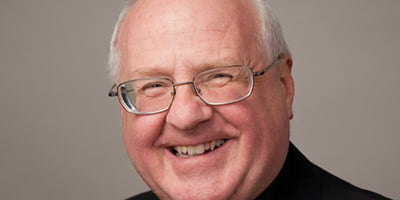
Father Mark Goldasich is the pastor of Sacred Heart parish in Tonganoxie. he has been editor of the Leaven since 1989.
by Father Mark Goldasich
How many books would you say are published in the United States each year? According to author John P. Flanagan, the number is an astounding 165,000! In his book, “Managing Your Time, Energy, and Talent in Ministry,” he notes that publishers expect only 15 percent of the books they produce to generate a profit; 40 percent to break even; and 45 percent to be financial losers.
With that in mind, I feel fortunate to have stumbled upon some great ones, which I’m recommending for gift giving this Christmas. Each should appeal to a wide variety of readers and all can be easily read by people in the pew who are interested in growing in their understanding of the Catholic faith.
The first is what I call a “coffee book,” something to pick up and read first thing in the morning — right after you put the coffee on to brew. By the time the coffee is ready, you’ve finished one of these short selections and are ready to face the day in a much better frame of mind. The book is “Prayers from Around the World and Across the Ages” (Chicago: ACTA Publications, 2004; 155 pgs; $9.95). This volume is chock-full of prayers, compiled by Victor M. Parachin, for every imaginable situation. Most come from the Christian tradition, though not all. Before each of the prayers, Parachin includes a short biography of the prayer’s composer. Readers can unite themselves with great saints like Teresa of Avila or Thomas Aquinas or with people like Florence Nightingale, Jane Austen, William Penn, Woodrow Wilson or Dag Hammarskjold.
Ever wonder who all those saints are on the calendar your parish gives out each year? A great educational resource is “Companion to the Calendar: A Guide to the Saints and Mysteries of the Christian Calendar” by Mary Ellen Hynes (Chicago: Liturgy Training Publications, 1993; 210 pgs.; $18). This book provides short summaries of those saints of the day. It also discusses the seasons of the church year (like Advent and Ordinary Time) and includes a short list and explanation of major Jewish and Muslim days.
Is the Bible a mystery to you? Two books can be extremely helpful in making it a source of inspiration, education and prayer instead. The first is “The Bible Made Easy: A Book-by-Book Introduction” by Father Timothy P. Schehr (Cincinnati, Ohio: St. Anthony Messenger Press, 2006; 246 pgs.; $16.95). In well-laid out and attractive pages, the author summarizes each book of the Bible (in plain English), outlines its chapters and themes, explains its historical setting, presents questions for reflection and highlights three spiritual lessons from the book.
The second book, by Karl A. Schultz, is called “How to Pray With the Bible: The Ancient Prayer Form of Lectio Divina Made Simple” (Huntington, Ind.: Our Sunday Visitor Publishing, 2007; 157 pgs.; $9.95). This interactive volume helps people to use the Bible in their personal prayer, by fusing it with their own life experiences. The book includes many helpful boxes such as prayer pointers, prayer passages and reflection questions.
An entertaining book is “50 Reasons I Love Being Catholic” (Chicago: Loyola Press, 2006; 270 pgs.; $13.95) by Liz Kelly, a thirty-something writer and jazz singer. Some of her reasons you’d expect to find: the Eucharist, the rosary, and Mary. Others, however, are really unique, like kneelers, the Scala Santa and Swiss Guards. This book will definitely have you reaching for a pen and paper to make a list of your own.
Many find reading history less than compelling. That can be especially true of church history. Dominican Father Guy Bedouelle seeks to remedy that with “An Illustrated History of the Church” (Chicago: Liturgy Training Publications, 2004; 271 pgs.: $100). Instead of charts and graphs, this coffee table book presents history primarily though art. A lot can be learned here simply by looking at the pictures and reading the detailed captions beneath them.
Lastly, pick up a copy of Don Brophy’s “One Hundred Great Catholic Books: From the Early Centuries to the Present” (New York: BlueBridge, 2007; 222 pgs.; $16). The author has done an excellent job of gathering books that have “nourished Catholic Christians and many other seekers over the centuries . . . and are considered worthy by readers to this day.” Each entry is just a couple of pages long, but it’s full of information: an excellent summary of the featured book, biographical notes of the author, and a short explanation of what this book can offer a contemporary reader.
I’d love to write more, but based on Brophy’s book, I’ve got a whole slew of items to add to my wish list before Christmas rolls around.

